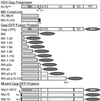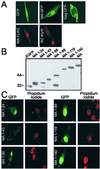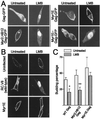Nuclear entry and CRM1-dependent nuclear export of the Rous sarcoma virus Gag polyprotein
- PMID: 11891341
- PMCID: PMC122628
- DOI: 10.1073/pnas.062652199
Nuclear entry and CRM1-dependent nuclear export of the Rous sarcoma virus Gag polyprotein
Abstract
The retroviral Gag polyprotein directs budding from the plasma membrane of infected cells. Until now, it was believed that Gag proteins of type C retroviruses, including the prototypic oncoretrovirus Rous sarcoma virus, were synthesized on cytosolic ribosomes and targeted directly to the plasma membrane. Here we reveal a previously unknown step in the subcellular trafficking of the Gag protein, that of transient nuclear localization. We have identified a targeting signal within the N-terminal matrix domain that facilitates active nuclear import of the Gag polyprotein. We also found that Gag is transported out of the nucleus through the CRM1 nuclear export pathway, based on observations that treatment of virus-expressing cells with leptomycin B resulted in the redistribution of Gag proteins from the cytoplasm to the nucleus. Internal deletion of the C-terminal portion of the Gag p10 region resulted in the nuclear sequestration of Gag and markedly diminished budding, suggesting that the nuclear export signal might reside within p10. Finally, we observed that a previously described matrix mutant, Myr1E, was insensitive to the effects of leptomycin B, apparently bypassing the nuclear compartment during virus assembly. Myr1E has a defect in genomic RNA packaging, implying that nuclear localization of Gag might be involved in viral RNA interactions. Taken together, these findings provide evidence that nuclear entry and egress of the Gag polyprotein are intrinsic components of the Rous sarcoma virus assembly pathway.
Figures






Similar articles
-
Detailed mapping of the nuclear export signal in the Rous sarcoma virus Gag protein.J Virol. 2005 Jul;79(14):8732-41. doi: 10.1128/JVI.79.14.8732-8741.2005. J Virol. 2005. PMID: 15994767 Free PMC article.
-
Insertion of a classical nuclear import signal into the matrix domain of the Rous sarcoma virus Gag protein interferes with virus replication.J Virol. 2004 Dec;78(24):13534-42. doi: 10.1128/JVI.78.24.13534-13542.2004. J Virol. 2004. PMID: 15564464 Free PMC article.
-
Importin-beta family members mediate alpharetrovirus gag nuclear entry via interactions with matrix and nucleocapsid.J Virol. 2006 Feb;80(4):1798-806. doi: 10.1128/JVI.80.4.1798-1806.2006. J Virol. 2006. PMID: 16439536 Free PMC article.
-
Visualizing Association of the Retroviral Gag Protein with Unspliced Viral RNA in the Nucleus.mBio. 2020 Apr 7;11(2):e00524-20. doi: 10.1128/mBio.00524-20. mBio. 2020. PMID: 32265329 Free PMC article.
-
Beyond plasma membrane targeting: role of the MA domain of Gag in retroviral genome encapsidation.J Mol Biol. 2011 Jul 22;410(4):553-64. doi: 10.1016/j.jmb.2011.04.072. J Mol Biol. 2011. PMID: 21762800 Free PMC article. Review.
Cited by
-
The C-terminal half of TSG101 blocks Rous sarcoma virus budding and sequesters Gag into unique nonendosomal structures.J Virol. 2005 Mar;79(6):3775-86. doi: 10.1128/JVI.79.6.3775-3786.2005. J Virol. 2005. PMID: 15731271 Free PMC article.
-
Live-cell coimaging of the genomic RNAs and Gag proteins of two lentiviruses.J Virol. 2010 Jul;84(13):6352-66. doi: 10.1128/JVI.00363-10. Epub 2010 Apr 14. J Virol. 2010. PMID: 20392841 Free PMC article.
-
Link between genome packaging and rate of budding for Rous sarcoma virus.J Virol. 2003 Sep;77(17):9388-98. doi: 10.1128/jvi.77.17.9388-9398.2003. J Virol. 2003. PMID: 12915554 Free PMC article.
-
Specificity of plasma membrane targeting by the rous sarcoma virus gag protein.J Virol. 2003 Jan;77(1):470-80. doi: 10.1128/jvi.77.1.470-480.2003. J Virol. 2003. PMID: 12477852 Free PMC article.
-
Detailed mapping of the nuclear export signal in the Rous sarcoma virus Gag protein.J Virol. 2005 Jul;79(14):8732-41. doi: 10.1128/JVI.79.14.8732-8741.2005. J Virol. 2005. PMID: 15994767 Free PMC article.
References
Publication types
MeSH terms
Substances
Grants and funding
LinkOut - more resources
Full Text Sources
Other Literature Sources

